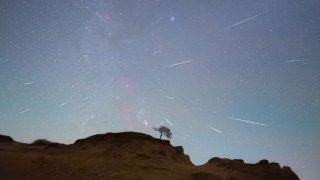
It's another great weekend to look up.
Reaching its peak on Oct. 21, the Orionids meteor shower will bring a glowing show of light and speed. The meteor-studded event has been described by NASA as “one of the most beautiful showers of the year” and will show streaks of light in the sky traveling at nearly 148,000 miles per hour.
Read on for more information on the Orionids meteor shower and how to catch it.
What is the Orionids meteor shower?
Get South Florida local news, weather forecasts and entertainment stories to your inbox. Sign up for NBC South Florida newsletters.
The Orionids meteor shower — commonly shortened to the Orionids — is a collection of meteors that appear during October.
As NASA notes, the Orionid meteors are fast, traveling into Earth’s atmosphere at some 148,000 miles per hour. With such speed, these meteors can leave glowing “trains” — what NASA describes as incandescent bits of debris. The meteors can also burst into fireballs, so be sure to look out for extended blasts of light as you gaze.
Where is the Orionids meteor shower visible?
U.S. & World
According to NASA, theOrionids meteor shower will be most visible in the Northern and Southern Hemispheres in regions farther away from city and street light pollution. Night owls will find the skies are in their favor during this time as showers will be the easiest to catch after midnight until dawn.
Some tips on how to watch the Orionids meteor shower
Based on information provided by NASA, here's some tips on how to watch the Orionids meteor shower.
- Those in the Northern Hemisphere should be sure to direct their attention southeast.
- Southern hemisphere dwellers should be sure to keep their eye leveled on the northeast.
- Give your eyes some time to adjust. According to NASA, 30 minutes or less in the dark should be enough to allow your eyes to properly adjust to see meteors.
On what days is the Orionids meteor shower visible?
The Orionids are active until Nov. 22, but will be at "peak" activity on Oct. 21.
How is the Orionids meteor shower connected to Halley’s Comet and Hoda Kotb?
This one’s a complex connection but easy to break down.
First, you should know that, according to Space.com, Halley’s comet is a periodic comet that enters into Earth’s vicinity every 76 years. The last time we saw it from Earth was in 1986.
The Orionids meteor shower is made up of debris and particles produced by Halley’s comet as it returns to the inner solar system. (If it’s been a while since your fifth-grade science class, you might have forgotten that the inner solar system is made up of four terrestrial planets —Mercury, Venus, Earth and Mars — and the asteroid belt.)
Finally, yes, Hoda Kotb is a shining star, but she’s not an astronomical object. However, she does have a close connection to Halley’s comet. Hoda’s daughter Haley was named after Halley’s comment.
Calling into TODAY in 2017, she shared how she came up with the name.
“It was one of those things: I just picture her sailing through the sky,” Hoda explained at the time.
This article first appeared on TODAY.com. More from TODAY:



